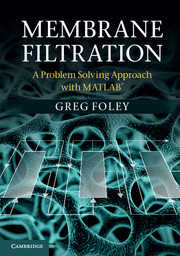Book contents
- Frontmatter
- Dedication
- Contents
- Preface
- Abbreviations
- 1 Introduction to membrane filtration of liquids
- 2 Dead-end filtration
- 3 Crossflow microfiltration
- 4 Ultrafiltration flux theories
- 5 Ultrafiltration process analysis and design at the limiting flux
- 6 Diafiltration at the limiting flux
- 7 Ultrafiltration and diafiltration with incomplete rejection
- 8 The osmotic pressure model applied to ultrafiltration and diafiltration
- 9 Reverse osmosis and nanofiltration
- 10 Membrane fouling
- Appendix Mathematical and computational background
- Index
- References
2 - Dead-end filtration
Published online by Cambridge University Press: 05 July 2013
- Frontmatter
- Dedication
- Contents
- Preface
- Abbreviations
- 1 Introduction to membrane filtration of liquids
- 2 Dead-end filtration
- 3 Crossflow microfiltration
- 4 Ultrafiltration flux theories
- 5 Ultrafiltration process analysis and design at the limiting flux
- 6 Diafiltration at the limiting flux
- 7 Ultrafiltration and diafiltration with incomplete rejection
- 8 The osmotic pressure model applied to ultrafiltration and diafiltration
- 9 Reverse osmosis and nanofiltration
- 10 Membrane fouling
- Appendix Mathematical and computational background
- Index
- References
Summary
Introduction to dead-end filtration
In Chapter 1 the various membrane filtration processes were classified and it was seen that filtration and microfiltration involve the separation of particulate matter from liquids. Filtration and microfiltration are essentially the same process but the term microfiltration is usually reserved for filtration of particles with diameters in the range 0–10 µm. Many biological suspensions, such as suspensions of bacteria or yeast, fall within this range. Typically, synthetic membranes (‘microfilters’) are used with pore diameters less than 1 µm in diameter and many companies manufacture membranes with pore diameters of 0.22 µm and 0.45 µm. Filtration is a technology that has been used extensively in more traditional chemical industries where separation of larger particles such as crystals may be required. For these bigger particles, synthetic membranes are not necessary and filter cloths with considerably large pore sizes are employed. Often, suspensions of smaller particles, such as yeast cells employed in brewing processes, are filtered with filter cloths rather than synthetic membranes. However, this requires use of filter aids as discussed later.
The important point to note throughout this chapter is that filtration and microfiltration operate on the same principle and the underlying theory covers both processes. Both terms are used at various times throughout this chapter.
- Type
- Chapter
- Information
- Membrane FiltrationA Problem Solving Approach with MATLAB, pp. 16 - 47Publisher: Cambridge University PressPrint publication year: 2013



